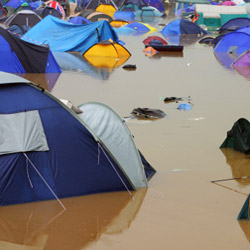
Around 135,000 tickets were sold in 2013, meaning for one weekend in June, a town with a population larger than Exeter springs up in a few Somerset fields. The entire site takes up 900 acres, with 62 stages and over 5,000 toilets. Michael Eavis organised the first festival back in 1970 as a one off event to raise some extra cash for the farm during the summer. Since then the festival has refused to die despite crowd trouble, fence jumpers and horrifically bad weather down through the years.
Glastonbury is famous for its mud, but is this a deserved reputation? Well there’s a dataset for that (although admittedly it has some limitations1). The Met Office has released historical weather data from all its weather stations across the UK. The nearest station to Worthy Farm (the home of the festival) is Yeovilton which is just 11 miles away.
The data only shows monthly averages, but as you can see in the graph, the weather hasn’t been overly unfair one way or the other over the years. It does confirm where the Glastonbury mud legend came from though.
{mbox:lightbox/yeovilton-weather-data-june.jpg|width=600|height=340|caption=Click to enlarge|title=Average rainfall and sunshine in the months/years the Glastonbury festival took place}
The 1982 event looks like a washout from the chart and indeed the highest rainfall for a single day in 45 years was recorded on the Friday of that year. The mud baths were seared into the festivals reputation when the years 1997 and 1998 saw torrential downpours and TV cameras were on hand to broadcast the filthy conditions across the nation.
However, 2005 truly was the worst year on record. A month's rain fell in less than two hours, and 300 tents were washed away in floods that reached six feet in depth in places. The next festival came in 2007 with another wet year, but by that time the organisers had spent around £750,000 on improving the site's drainage.
Biblical weather like 2005 will always bring more publicity than the sunshine years like 2008. This year’s forecast is not looking too promising so far, but the 2014 festival sold out in record time back in October, so this article is admittedly useless. No one goes to Glastonbury for the weather, if you want sunshine, go to Gran Canaria.
References
- 1. The Met Office data contains monthly averages from June across years that the festival took place (the 1970 festival took place in September and the 1978 festival in July). Data for average sunshine hours only begins in 1984. Some of the data is incomplete, 2005 is missing sunshine records and the dataset only goes up to May 2013, so last year does not appear.



